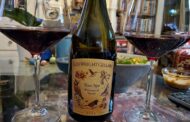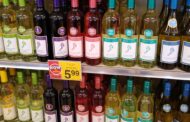Layne’s Wine Gig Presents
LITTLE LOVELIES
By Layne V. Witherell
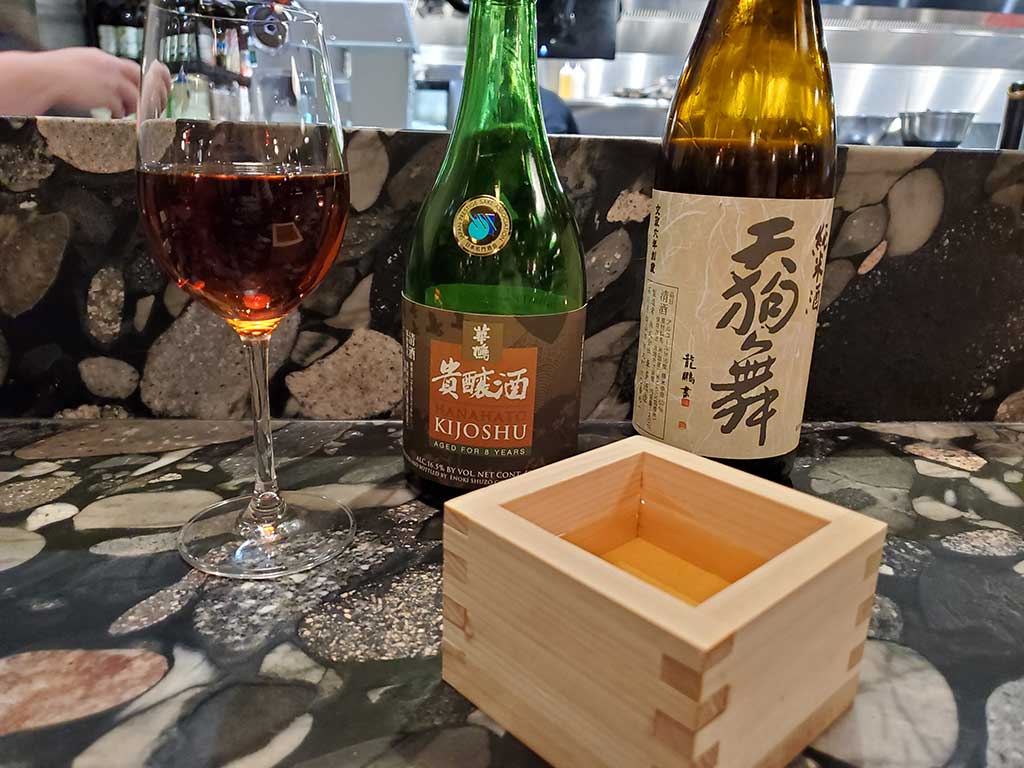
First, let me give a heartfelt thanks to The New York Times for letting us all feel both hip and sake empowered. Their “little lovely” of Feb. 27th, 2023, “Sake is booming in America,” was – as usual – Brooklyn centric and New York aspirational.
The article introduced us to new rarities like IWA 5 (for a mere $200.00 a bottle) with a “blending process that challenges the boundaries of sake.” It is the creation of Richard Geoffrey, the former blender of Dom Perignon. Need I say more? It is so refreshing to see both you and your wallet tumbling down the ol’ beverage adventure (wine, craft beer, rare bourbon) rabbit hole that is marketing and social media. Oh, and don’t forget the social media influencers.
My ”little lovely” article on sake was in The West End News June 2021 print edition. It was a piece that investigated new sake and food pairings. After long thought and deliberation afterward: there are two ways that you can go with sake. First is what I call the “sake somm obsessed.” That involves getting to know all thousand plus breweries in Japan as well as the hundreds emerging soon in Bushwick, Brooklyn. And don’t forget Oregon (the largest sake market in America). Sorry, the Times article forgot Oregon. With this mindset, it is important to learn every style, sweetness level, and producer.
The second way to go with sake is very different. And you can start by going to…
BAR FUTO
425 Fore St., Portland
Small, deliriously good plates: scallop crudo, charred Hamachi, uni (the delicious innards of the sea urchin) over potato mochi. Much love to the skewers of duck breast and scallops with miso. All carefully accompanied with some very well thought out sake pairings.
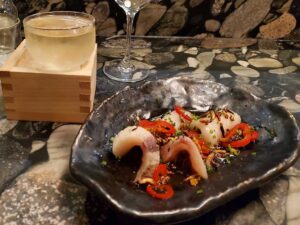
- Dassai Junmai Daiginjo Nigori (coarse filtration and cloudy), $14.00 a glass. Delicate and elegant with the scallops.
- Dance of the Demon, $18.00 glass. Moving on up in flavor and complexity with the uni. Judy’s favorite. A full, nutty, earthy sake.
- Taru Cedar Sake, $14.00 glass. You drink it from a little wooden box. Like oak? Like cedar? Like drinking from a little wooden box? This is it.
- Hanahoto Kajoshu Junmai (8 years old), $18.00 a glass. Looks like an ancient Spanish sherry and is the greatest accompaniment to duck breast and prune sauce on a skewer imaginable. Thanks to Chet at the bar. I never would have found that one!
If great food and wine pairings are your thing, alongside décor, service, and ambiance… This is your place.
Frankly, I think that the only thing that you need to look for on a sake label, as the kanji (Japanese script) will drive you crazy, is the word Diagingo. This is the quality level of rice milled to 50% of its outer layers polished away. Rare, captivating, and delicious. Have it cold with any food. Problem solved.
You may not be an expert, but you now have confidence to roll up to your local “sake somm” and throw down a statement. And you will be getting the finest sake for your money.
SOPO SEAFOOD
171 Ocean St., South Portland
A “little lovely” close to home. After spending a week in New Orleans staring at wine lists that featured and extolled $14,000 bottles of Domaine Romanee Conti and $22,000 bottles of Chateau Petrus, it is beyond refreshing to revisit one of our favorite “little lovely” wine lists.
It has changed since our last visit in February of last year. Changed in a more complete, affordable, and utterly delightful way. They are a model for small wine lists. They won’t win a Wine Spectator Grand Award (no Master Somm, no Opus One at $780.00 a bottle). Just consistency, value, and a wine that will pair with each of their delightful dishes. This visit: lobster bisque, a great selection of Maine oysters, and a crab sandwich to dip in your bisque.
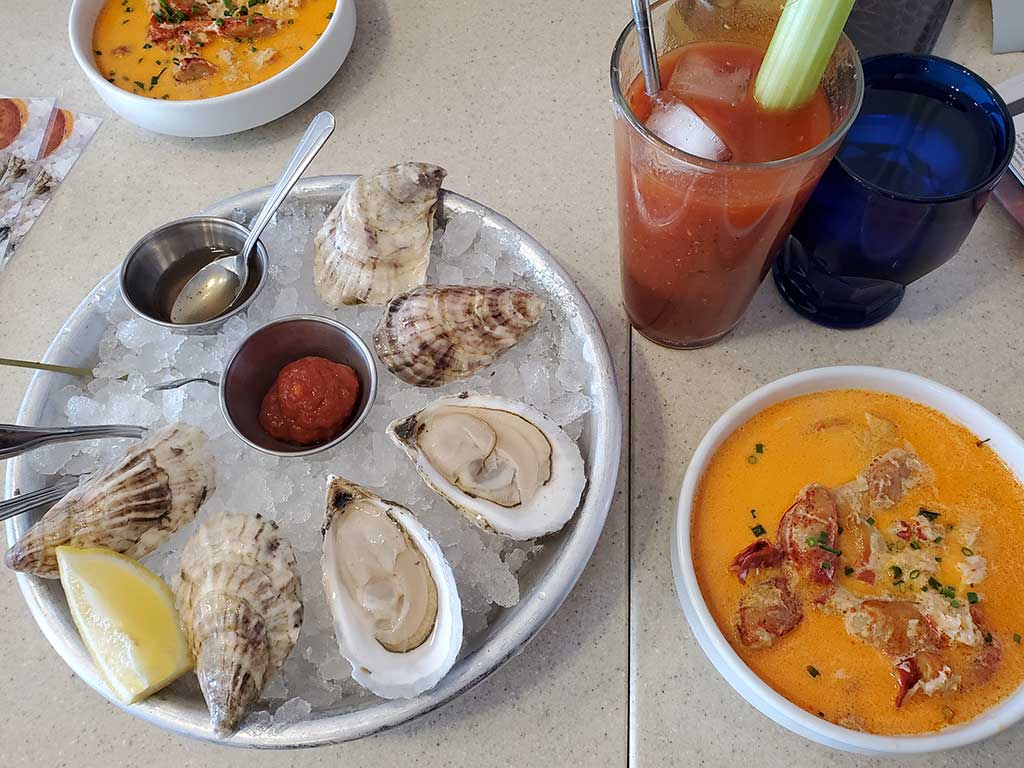
Our guide to all things SoPo Seafood was Lucas Myers, Director of Operations and seer of all dishes and beverages. Here are highlights from their twenty well-chosen wines:
- TURBULLENT – Gamay Sparkling Rose, France, $12.00 glass/$35.00 bottle. Gamay rose steps the game up from sparkling Provence and Italian Prosecco. More blackberries than strawberries in flavor with moderate fruitiness. A nice ride. A different ride.
- LUBANZI – Chenin Blanc, South Africa, $8.00 glass /$25.00 bottle. For this food and its surroundings, the Chenin Blanc is perfect. A touch of sweetness and enough body to go with all the dishes. If you don’t know South African wines, it is time to start. And this is a great place to start.
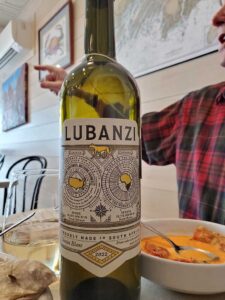
A note on poor, misunderstood South African wines:
First: their lovely Chenin Blanc grape was called Steen. Confusing? Yes. Few recognized the name. Then the best vines, the oldest in the world, were used to make a ho hum Brandy or stuck unceremoniously into a bag in the box to be sold on the “cheap and cheerful” world in England. A shame. The real shame is that the tourists who visited the picture-perfect wineries were told that THE grape of South Africa was the Pinotage, a noisy red grafting of Pinot Noir and Cinsault. At its best it is bold. At its worst it tastes of road tar. You decide.
- GUARDIAN’S- Rkatsiteli, Republic of Georgia, $10.00 glass/$30.00 bottle. Gloriously dry with high acidity to cut through the oysters and lobster bisque. A perfect shellfish pairing. There is always a hint of minerals and pepper in “Rkats,” as it is affectionally called.
There are lots of legends like the first vine planted by Noah after the flood. But we do know it is an ancient Georgian grape. I first saw the grapes in the 1970’s on a visit to the Concannon Winery in Livermore, California. They imported Sauvignon Blanc in the early part of the 20th century from France along with Petite Syrah, a little-known blending grape from the south of France. Enter “Rkats” as their little grape adventure in the 1960’s.
Because of its ability to withstand extreme cold Dr. Konstantin Frank of New York State (“it gets so cold here that your spit freezes before it hits the ground”) and Dennis Horton of Barboursville, Virginia, both have tried their luck. Both wines are worth searching out. The grapes are familiar with the cold, much like those raw oysters on your plate. Great call, Luke.
And the one wine that belongs on every list…
Turbullent Gamay, Rkatsiteli from Georgia, and Lubanzi Chenin Blanc from South Africa may be new finds to you, but the one wine that belongs on every list (sorry, Prosecco and New Zealand Sauvignon Blanc) is Pinot Gris from Oregon.
- ROOTS-Pinot Gris, Willamette Valley, Oregon, $8.00 glass/$25.00 bottle. Everyone should have a Pinot Gris on their list. It is vastly better than cheesy Pinot Grigio. I have said that before.
There are three sakes on their list. I was contemplating asking, but Luke was into a deep dive caviar dialog with a customer. It was so illuminating – his animated take accompanied by the raft of customers’ questions – that I forgot to ask.
Take that to New York. We have our own “little lovelies”!

